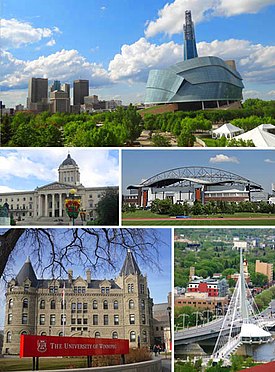
Back Winnipeg Afrikaans وينيبيغ Arabic وينيبيج ARZ Winnipeg AST Vinnipeq Azerbaijani وینیپئق AZB Вініпег Byelorussian Вініпэг BE-X-OLD Уинипег Bulgarian উইনিপেগ Bengali/Bangla
Winnipeg | |
|---|---|
City | |
| City of Winnipeg Ville de Winnipeg | |
 Clockwise from top: Downtown featuring the Canadian Museum for Human Rights, Investors Group Field, Saint Boniface and the Esplanade Riel bridge, Wesley Hall at the University of Winnipeg, Manitoba Legislative Building. | |
| Nicknames: | |
| Motto(s): | |
| Coordinates: 49°53′58″N 97°08′21″W / 49.89944°N 97.13917°W | |
| Country | Canada |
| Province | Manitoba |
| Region | Winnipeg Capital |
| Established | 1738 (Fort Rouge) |
| Renamed | 1822 (Fort Garry) |
| Incorporated | 1873 (City of Winnipeg) |
| Government | |
| • Mayor | Scott Gillingham |
| • Governing body | Winnipeg City Council |
| • MPs | List of MPs |
| • MLAs | List of MLAs |
| Area | |
| • Land | 464.08 km2 (179.18 sq mi) |
| • Metro | 5,306.79 km2 (2,048.96 sq mi) |
| Elevation | 239 m (784 ft) |
| Population | |
| • City | 705,244 (7th) |
| • Density | 1,430/km2 (3,700/sq mi) |
| • Urban | 705,244 (7th) |
| • Urban density | 1,429/km2 (3,700/sq mi) |
| • Metro | 778,489 (8th) |
| • Metro density | 146.70/km2 (380.0/sq mi) |
| Demonym | Winnipegger |
| Time zone | UTC−6 (CST) |
| • Summer (DST) | UTC−5 (CDT[12]) |
| Forward sortation area | |
| Area code(s) | 204 and 431 |
| Website | www |
Winnipeg (pronounced /ˈwɪnɨpɛg/) is the largest city of Manitoba, Canada. It is in the eastern prairie region of western Canada. It is often called the "Gateway to the West".[13][14] Winnipeg is the seventh biggest city in Canada with a population of 705,244 people.[15]
The name "Winnipeg" comes from the Cree word for "muddy waters." Winnipeg is at the place where the Red River and Assiniboine river join. That area is known as The Forks.
Winnipeg has four professional sports teams. The teams are the "Winnipeg Blue Bombers" who play football, the "Winnipeg Jets" who play hockey, the Winnipeg Goldeyes who play baseball and the Winnipeg Alliance FC who play soccer. Winnipeg has four universities: the University of Manitoba, the University of Winnipeg, Canadian Mennonite University and University of St. Boniface.
Winnipeg is in a very flat part of Canada. Winnipeg has four rivers in it. These rivers are the Red River, the Assiniboine River, the La Salle River, and the Seine River. Winnipeg has floods in spring a lot because it is in a very flat area that gets a lot of snow and rain. In winter, Winnipeg is cold and gets a lot of snow. The hottest day in Winnipeg was in the year 1936, when it was 42 degrees Celsius. The coldest day in Winnipeg was in the year 1879, when it was -47 degrees Celsius.
- ↑ Goodhand, Margo (10 October 2012). "Winnipeg Now was 100 years in the making". Winnipeg Free Press.
- ↑ Williams, Rob (31 December 2011). "Live ... in the Peg!". Winnipeg Free Press.
- ↑ Kives, Bartley (2 December 2012). "Proud to be Winterpeg". Winnipeg Free Press.
- ↑ Municipal Manual. City of Winnipeg. 2007. p. 16.
- ↑ "Census subdivision of Winnipeg". Statistics Canada. 8 February 2012. Retrieved 3 March 2014.
- ↑ "Census metropolitan area of Winnipeg". Statistics Canada. 8 February 2012. Retrieved 3 March 2014.
- ↑ "Census Profile, 2016 Census Winnipeg Census metropolitan area". Statistics Canada. 8 February 2017. Retrieved 8 February 2017.
- ↑ "Census Profile, 2016 Census Winnipeg, City". Statistics Canada. 8 February 2017. Retrieved 8 February 2017.
- ↑ "Population and dwelling counts, for Manitoba and census subdivisions". Statistics Canada. 8 February 2012. Retrieved 6 April 2012.
- ↑ "Metropolitan areas of Manitoba". Statistics Canada. Retrieved 8 February 2011.
- ↑ "Population counts, for census metropolitan areas, census agglomerations, population centres and rural areas, 2011 Census". Statistics Canada. 11 April 2012. Retrieved 10 August 2012.
- ↑ "Winnipeg". The World Clock. Retrieved 3 March 2014.
- ↑ Imperial Oil website. "Winnipeg History". Archived from the original on 2007-01-27. Retrieved 2008-06-15.
- ↑ City of Winnipeg website. "Winnipeg History". Retrieved 2008-06-15.[permanent dead link]
- ↑ "Population and dwelling counts, for census metropolitan areas, 2011 and 2006 censuses". Retrieved 12 November 2012.



